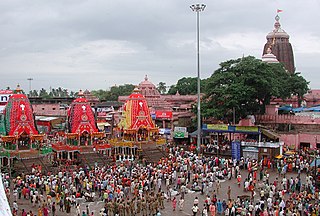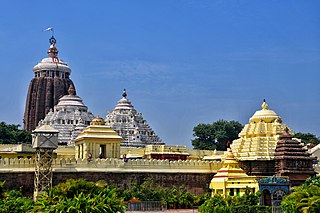
Jagannath is a deity worshipped in regional Hindu traditions in India and Bangladesh as part of a triad along with his brother Balabhadra and sister, devi Subhadra. Jagannath within Odia Hinduism is the supreme god, Purushottama, Para Brahman. To most Vaishnava Hindus, particularly the Krishnaites, Jagannath is an abstract representation of Krishna, sometimes as the avatar of Krishna or Vishnu, to some Shaiva and Shakta Hindus, he is a symmetry-filled tantric form of Bhairava.

Ratha Yatra is a Hindu festival associated with Lord Jagannath held at Puri in the state of Odisha, India. It is the oldest Ratha Yatra taking place in India and the World, whose descriptions can be found in Brahma Purana, Padma Purana, and Skanda Purana and Kapila Samhita.

Puri is a coastal city and a municipality in the state of Odisha in eastern India. It is the district headquarters of Puri district and is situated on the Bay of Bengal, 60 kilometres (37 mi) south of the state capital of Bhubaneswar. It is also known as Sri Jagannatha Dhama after the 12th-century Jagannath Temple located in the city. It is one of the original Char Dham pilgrimage sites for Hindus.

The Jagannath Temple is an important Hindu temple dedicated to Jagannath, a form of Vishnu, in Puri in the state of Odisha on the eastern coast of India. The present temple was rebuilt from the 10th century onwards, on the site of an earlier temple, and begun by Anantavarman Chodaganga Deva, the first king of the Eastern Ganga dynasty.
The birthplace of the great twelfth-century poet Jayadeva has been disputed, with the neighboring states of Odisha and Bengal in eastern India staking a claim. This had led to a bitter feud between people on both sides that lasted for over a century. The issue is still debated by scholars.

The Gajapati Empire was established by the Suryavamsa or Routray dynasty, who were a medieval Hindu dynasty from the Indian subcontinent, which originated in the region of Odradesha from 1434 to 1541 CE. Under Kapilendra Deva, Gajapatis became an empire stretching from the lower Ganga in the north to the Kaveri in the south.

The Eastern Ganga dynasty also known as Rudhi Gangas or Prachya Gangas were a medieval Indian dynasty that reigned from Kalinga from as early as the 5th century to the early 15th century. The territory ruled by the dynasty consisted of the whole of the modern-day Indian state of Odisha as well as major parts of West Bengal, Andhra Pradesh and Chhattisgarh. The early rulers of the dynasty ruled from Dantapuram; the capital was later moved to Kalinganagara, and ultimately to Kataka . Today, they are most remembered as the builders of the world renowned Puri Jagannath Temple and Konark Sun Temple, a UNESCO World Heritage site at Konark, Odisha.
The Madala Panji is a chronicle of the Jagannath Temple, Puri, Odisha, India. It describes the historical events of Odisha related to Lord Jagannath and the Jagannath Temple. The Madala Panji dates from the 12th century.

Kapilendra Deva was the founder of the Suryavamsa Gajapati Empire that ruled parts of eastern and southern India, including present-day Odisha as the center of his empire. He had staged a military coup against the preceding and the last Eastern Ganga dynasty ruler Bhanu Deva IV and overtook the throne as the king was weak and had lost territories to the south. His name is also written as Kapilendra Routray or Sri Sri Kapilendra Deva. In claiming descent from the Surya Vamsha of the Mahabharata, he also took the title shri shri ...(108 times) Gajapati Gaudeshwara NabaKoti Karnata Kalabargeswara. This title literally meant the lord of Bengal (Gauda), of Karnataka region or Vijayanagara kingdom, of Golkonda kingdom and of nine crore subjects.
Gahana Bije, is the ceremonial visit which is done by once in a generation of Gajapati Queens of Odisha where they do special Puja to Lord Jagannatha.

Shri Shri Hari Baladev Jew Bije is a famous Hindu temple located in Baripada, Mayurbhanj district, in the state of Odisha, India. The name Jagannath is a combination of the Sanskrit words Jagat (Universe) and Nath.
Shri Jagannath Temple Act, 1955 is an Act of Odisha Legislative Assembly enacted to control the management and affairs of the Jagannath Temple at Puri.

Vira Pratapa Purushottama Deva was the second Gajapati emperor of Odisha who ruled from 1467 to 1497 C.E. He was the second ruler from the Suryavamsa Gajapati Empire. His father Gajapati Kapilendra Deva Routaraya chose him as his heir to rule Odishan Empire at the banks of river Krishna where he breathed his last. This decision infuriated the elder brother Hamvira Deva who was a battle hardened and successful warrior fulfilling the task of conquering the southern territories and expeditions against the kingdom of Vijayanagara as wished by his father.

Prataparudra Deva was the third Gajapati emperor of Odisha from the Suryavamsa Gajapati Empire started by his grandfather Kapilendra Deva Routaraya. He ruled from the year 1497 to 1540 A.D. Besides being a ruler, he was a devout Vaishnava and adherent of the famous saint, Sri Chaitanaya who arrived in Odisha during his rule. His life was extremely occupied with overwhelming military campaigns in defense of his inherited territory from three frontal invasions by the enemy states Vijayanagar, Hussain Shahi dynasty of Bengal and Qutb Shahi dynasty of Golconda. He lost large portions of his territory to the neighboring enemy states initiating the dissolution of Odisha's military hegemony and imperial status that continued for nearly a period of 600 years before him.

The Odia calendar is a lunisolar calendar followed in the state of Odisha, India. The calendar follows the sidereal solar cycle while using the lunar Purnimanta phase for the religious dates. The New Year in the Odia calendar is known as Pana Sankranti. It occurs on the first day of the traditional solar month of Meṣa, hence equivalent lunar month Baisakha. The Odia calendar follows the Amli era, which began on Bhādra śukla dvādaśī from 592 CE.

The Bhoi dynasty or the Yaduvamsa dynasty, were a medieval Hindu dynasty from the Indian subcontinent, which originated in the region of historical Odra that reigned from 1541 to 1560 CE. He had usurped the throne from the later weaker Suryavamsa Gajapati Empire rulers as the kingdom started weakening but had a short-lived reign as ruling chiefs of Odisha as the ensuing internal rivalries and constant threats of invasions rendered them weak and were eventually overthrown by Mukunda Deva of Chalukya dynasty in 1560.
Anka year system is a unique regnal year system used in the state of Odisha, India and was instituted by the rulers of the Eastern Ganga dynasty for dating their reigns. It had a number of features that mark the regnal year different from that actual duration of the year elapsed during the reign. The system still survives today and is used in the Odia calendar (panji) to mark the titular regnal year of the King of Puri which is currently held by Gajapati Maharaja Dibyasingha Deva IV of the Eastern Gangas of Puri, whose title carries the legacy of the historical ruling monarchs of Odisha.
Gajapati Rāmachandra Deva I was the founder of Bhoi dynasty of Khurda in Odisha. He became the ruler of Utkal after defeating Mukunda Deva in 1568. He claimed descent from the Yaduvamsa of Mahabharata. The Odia populace gave him the title of " Thākura Rājā " as a mark of respect for renovating the damaged Hindu temples that were destroyed by the invasion of Kalapahad. He was titled as Vira Sri Gajapati Viradhi Viravara Pratapi Ramachandra Deva.
The Eastern Gangas of Puri are a branch of the Eastern Ganga dynasty which succeeded the Bhoi dynasty as the ruling kings of Puri and inherited the titular legacy of the historical ruling chiefs of Odisha invested in the title of Gajapati. They also exercised administrative control of the Jagannath Temple at Puri.












